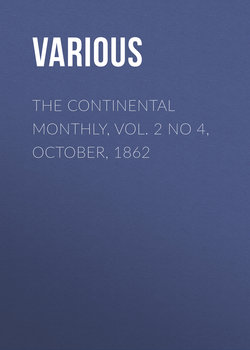Читать книгу The Continental Monthly, Vol. 2 No 4, October, 1862 - Various - Страница 4
MACCARONI AND CANVAS
SMALL-HOG GAME
ОглавлениеWhat this might be, our artists had yet to learn; it sounded slightly sensual for a Sunday amusement, but as there was a bishop in the town, and nothing could consequently be permitted that would shock, etc., etc., Caper, Rocjean, and Dexter at once agreed to assist the heads of the church in their pious endeavors to celebrate the day—as the Romans do. Not far from where they were standing, at the foot of wild rocks and the ruins of an old Roman watchtower, was a curious basin cut in the solid rock, its sides lined with large blocks, and its circular form preserved entire; its depth was from five to seven feet, and its bottom was like the sides, paved with smooth blocks. It was popularly said to have been anciently a cistern, a fish-tank, etc., but nothing was known definitely as to its original purpose; it now served for the circus, where the Small-Hog Game was annually indulged in.
About twenty-two o'clock, (that is, six in the afternoon,) the audience and spectators—for it was an audible as well as visible entertainment—being assembled and desirous for the performance to commence, whistled and shouted slightly, but not indecorously; for the grand army of the town—seven gendarmes—were around. Our three artists mounted up the rocks overhanging the cistern, and looked down on the heads of the people. They saw a thousand or two female heads, mostly with light hair, all pulled directly back from the forehead, twisted into a knot behind, and tied with a piece of string, while a silver bodkin a foot in length, run in sideways, held it tight. The heads of these silver hair-pins indicated the married or unmarried state of the wearers; the former were fashioned as acorns or flower-buds, while the latter were full-blown flowers with expanded petals. The faces of these women were tanned, but ruddy health was there and robust forms; and you saw among them all a very happy, contented, ignorant look, showing a satisfied condition of heart, without endless longings for the unattainable and dim—they always had 'the dim' about them in the shape of the one-horse lamps of the country, a saucer of oil with a piece of twine hanging over the edge for a wick. By the way, the Acadiens on Bayou La Fourche in Louisiana have the same 'lampion' light!
The dress of these women was plain, but strong and serviceable. White shirts in full folds covered neck and bosom, the sleeves hanging from the shoulder in large folds, a boddice of dark blue cloth was laced tightly around their waists, while skirts, generally of dark blue cloth, hung in heavy lines to their ankles.
The men, assembled there to the number of about two thousand, were accoutred in blue cloth jackets, (which rarely have the owners' arms in the sleeve, but are worn as cloaks,) red waistcoats of startlingly crimson color, and blue small clothes, while conical black felt hats, adorned here and there with flowers, served for head-coverings. A large assemblage of children, dressed and undressed, filled up the gaps.
Suddenly, Bang, Bangity Bang! and a row of small mortars were fired off in succession, and a small boy with a banner in his hands, and an Irish pennant in his wake, appeared marching slowly along. On the banner was a painting of a small black hog between two men, each armed with brooms, who seemed bent on sweeping it out of existence; over these were the words:
